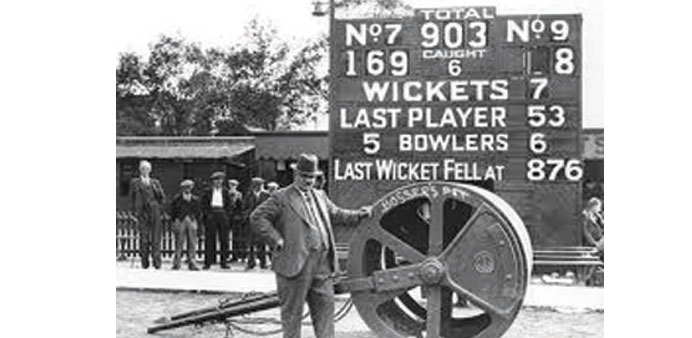By Mike Selvey/The Guardian
It is one of cricket’s iconic photographs. There poses Bosser Martin, groundsman at The Oval before the second world war, besuited and wearing a snappy hat, with his left hand resting proudly, almost affectionately, on Bosser’s Pet, his heavy roller. Although he looks as if he could have done a decent job by simply walking up and down the pitches himself, Bosser and his boys would trudge the roller back and forth until the surface resembled concrete.
The fruits of this particular labour are shown on the scoreboard behind him: this was August 1938 and so unforgivingly true had his pitch been that Len Hutton made 364 of England’s 903 for seven, before beating Australia by an innings and 579 runs.
Groundsmen love the heavy roller. Once, horse or man-power did the job of hauling a couple of tons of metal for hours on end. In more modern times it has been motorised and they can sit on it, in reverie, chugging rather than trudging.
In 2000 the Edgbaston groundsman, Steve Rouse, rolled his Test pitch so enthusiastically that he became known as Rawhide, because he was always rollin’, rollin, rollin’: so much so that grass could only grow through the cracks, which it did in clumps. Curtly Ambrose’s first ball of the match rose from a length, went straight over Mike Atherton’s head and that of the keeper, and clattered into the boundary.
What the players feel about it is another matter. There was a time when the familiar sound of the roller’s motor coughing into life would be heard at the fall of the ninth wicket, just in case it was needed. Whether or not this was to be the case would then be signalled by the captain of the side to bat as he left the field, the gesture timelessly familiar as if conveying the disparity in height between Steven Finn (the heavy roller) and James Taylor (the light one).
Whether, in general, anyone really understood how choosing one over the other made any difference is debatable. I never, for example, saw a heavy roller break up a pitch, not even the giant corporation road roller used at Southport one year, which had a vibrate mode engaged by the Middlesex players when the groundsman had decanted briefly to his shed. But a pitch that was turning always received nothing more than a light roll and general tidy, a wash and brush up as it was known.
Where it does have a real effect, though, is when the pitch is soft, the sort of condition that can prevail at this time of year. When the pitch is receptive to the ball, it dents, leaving marks so that it resembles the dimples on a golf ball. If these then harden up under the sun, they can result in uneven bounce, often to a startling degree, and extravagant movement sideways as the ball lands on one part or another of these indentations.
Whatever one feels about this, even as a downtrodden bowler, it does not make for good cricket. Four years ago, from the start of the 2010 season, the ECB decided that batsmen were having things too easy, spinners were getting a raw deal and so decided to introduce a playing condition that rewrote the relevant law, to whit: “Law 10.1 © is replaced by: ‘a roller heavier than 254kg may not be used after the commencement of the match’.” No heavy roller, in other words, to get rid of the dents. The result was open season for bowlers. Last summer there was a reversion to the original law, which allows the batting side up to seven minutes’ use of their roller of choice.
The result of that was open season for batsmen instead. Double hundreds became a devalued currency, even in sappy spring conditions.
So now we have to have more tinkering, just to complicate matters (it is fundamental to cricket that there has to be at least one regulation inexplicable to anyone other than those who come up with these ideas). This season, then, allows for either side to have use of the heavy roller once during the course of a match and that for a maximum of seven minutes. Which is odd in itself, but made even more so by the proviso that this is only providing that the home captain decides that a heavy roller should be available in the first place.
To me it all looks like unnecessary interference: if there is a roller, use it. The game and the laws and regulations by which it is played are complex enough as it is. Who knows what Bosser would have made of it, but he does not look like a fellow to stand on ceremony.

Bosser Martin with his heavy roller at The Oval in 1938.


